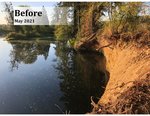


A November rainstorm was the first big test for a new bank stabilization project along a stretch of the Newaukum River, and the Lewis County Public Works Department reports it passed with flying colors.
The project, completed between March and October last year, engineered interlocking barriers into a section of eroded bank that had previously been declared a state of emergency by the Lewis County Board of Commissioners.
Further crumbling of the outer bank is now being avoided because of the large barriers that were added to the river during the project. These structures block much of the riverflow force from hitting the unstable riverbank.
“We were able to assess the site after both the high water levels and the increased flow intensity,” Public Works Director Josh Metcalf said in a statement. “The barriers did exactly what they were supposed to in protecting the outer bank.”
The eroded bank in question is located near a natural bend in the main fork of the Newaukum, adjacent to Newaukum Valley Road just past milepost 1. Rainstorms brought increased riverflow, which deteriorated the bank, creating a threat to public safety and the potential failure of roadway infrastructure.
With the state of emergency in place, Public Works was able to expedite engineering and permitting as county staff identified potential solutions. Due to natural forces causing the issues, Lewis County was able to access Federal Emergency Management Agency (FEMA) funds for the design and construction of the bank stabilization project. With 87% of the project’s cost covered by FEMA, Public Works was able to address the approximately $700,000 issue without having to reallocate funds from other projects that had already been planned and budgeted.
The county hired Olympia-based Northwest Hydraulic Consultants (NHC) as the engineering firm to lead the design of the bank stabilization project. NHC used a “ballasted log jack” method, which included 43 interlocking barriers, laid in a staggered pattern at strategic depths and locations in front of the weakened outer bank, to disperse the energy of the water flow.
Design of the barriers allows large rocks, wood and other debris to fill pockets in the structure, further protecting the outer bank as time goes on.
“The jacks have settled and are collecting sediment and debris that will assist in protecting the roadway infrastructure and safety of the roadway users,” Metcalf in a statement. “The extensive amount of coordination was done on an aggressive timeline for the nature of this work, especially with the necessary in-water work … A huge thank you to the Public Works staff, engineering consultants, regulatory agencies, and Tunista Construction, that worked collaboratively to make all that coordination happen and make this project a success.”